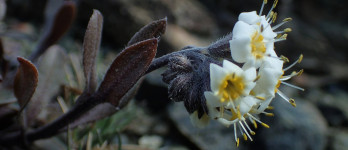Dun Mountain

The Dun Mountain mineral belt is a unique geological area of high country located south-east of Nelson City, with Dun Mountain itself reaching a peak of 1129m. It is unique for its high mineral content rocks, toxic low fertility soils and its harsh climate.
Deep within the earth, 280 million years ago, molten hot lava oozed its way into the overlying continental crust of Gondwana, creating the conditions to form this unique environment. Commonly called the Nelson Mineral Belt, it extends from D’Urville Island in the north to the Red Hills in the south.
The rocks and soils of the Mineral Belt are high in iron, magnesium, cobalt and nickel. Many native plants and animals usually found living at this altitude will not survive here. However, over millions of years, plant and animal communities have adapted to survive in the toxic, low fertility soils and harsh climate of this unique place, communities that can’t be found anywhere else in the world. This unique environment is under threat; if we lose it, it will be gone forever.
The native forests of the upper Maitai and Roding rivers stretch from the mineral belt towards the city and to Mt Richmond Forest Park and hold a range of different forest types. The mineral belt and forests combine to a 10,000 ha area that is important for both its function as the source for Nelson’s drinking water and its exceptional biological diversity of species and ecosystems.
As a recreation resource, it offers a back-country tramping and mountain biking experience like no other. Nelson Nature's Dun Mountain Brochure details the special attributes of the Dun Moutain ecosystem.
What is Council doing?
Nelson Nature’s habitat restoration and pest control programmes are working to protect the native plants and animals of the mineral belt and Maitai and Roding forests. Nelson Tasman Forest and Bird have established a partnership with Nelson City Council to support this area and have provided additional funding for this work.
Nelson Nature is working to control known weed species. Douglas fir, one of the most virulent seed spreaders of all the wildling conifers, is being retired from Council’s plantation forestry plantings.
- Control of wilding conifers, gorse and Spanish heath in the mineral belt
- Control of goats and other understory browsers to assist natural forest regeneration
- Weed control in forests targeting old man’s beard, banana passionfruit, climbing asparagus and other introduced pest species.
- Surveys for rare plants, Powelliphanta snails and Nelson green geckos to understand their distribution and management needs
How you can help
- Don’t bring new plant seeds into the area.
- Pull out any small wilding pines you see.
- Support habitat restoration and pest control programmes.
- Take only photographs.
- Record your observations on iNaturalist
- Do not collect snail shells – leave them where they are to allow the calcium within the shells to return back to the land for other snails to use.
Note that all Powelliphanta snails are fully protected under the Wildlife Act 1953, so neither live snails nor empty shells can be collected/removed.
-
Dun Mountain animals
Read MoreThe most spectacular creature found in among the rocks and roots of the Dun Mountain is a sub-species of New Zealand’s Giant Land Snail.
-
Dun Mountain Plants
Read MoreThe Dun Mountain’s high mineral content alpine environment is home to around 28 plant species, most of which are classified as threatened, rare or that only grow in a limited range.
-
Dun Mountain Threats
Read MoreThreats to the Dun Mountain environment include wilding pines and browsing animal pests



